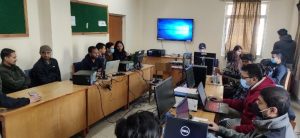 Course overview
Course overview
This course focuses on how social groups and networks evolve, interact, and are supported with computer systems. It covers social, scientific, and technical concepts of social computing in terms of computer systems supporting social behaviour, socially intelligent computing carried out by communities, and human computation and crowd sourcing systems.
Participants in piloting
The course is an elective course offered in IT related M.Sc. programs of IOE, Tribhuvan University. Up to 20 students are typically enrolled in the course each year.
Use of ALIEN services and tools
Students were divided into groups of 3 – 4 individuals. Each group was assigned a project related to social computing systems. For example, a project may focus on the development of a system for sentiment analysis of tweets in a certain theme.
Each group of students collected and reviewed materials on the web and campus intranet. They explored existing systems from the web and presented a project proposal. Each group presented their project idea and received feedback by other groups and the instructor. Subsequently, each group developed a prototype. Teams demonstrated their prototypes in their final presentation to all other groups, the instructor, and other faculty members.
The activity took place in the ALIEN problem-based learning lab, which includes workstations, projectors, and internet support. Students developed their software using coding environments and API’s related to social media interaction. They used Microsoft® PowerPoint to deliver their presentations. Students used as reference educational resources on the fundamentals of social computing as well as related books available on the internet.
In the beginning of the course the students used workstations and lab connectivity to explore sources and collect required data and documents. They downloaded the material from the internet and proposed a project title based on their research. Subsequently, students setup the required software development environment on the computers for developing the software code required for their project. Each group delivered 2 presentations. The 1st presentation focused on a solution proposal. Students received feedback on their idea by the instructor. The 2nd and final presentation focused on a demonstration of their completed project. The presentations were the basis for student evaluation.


